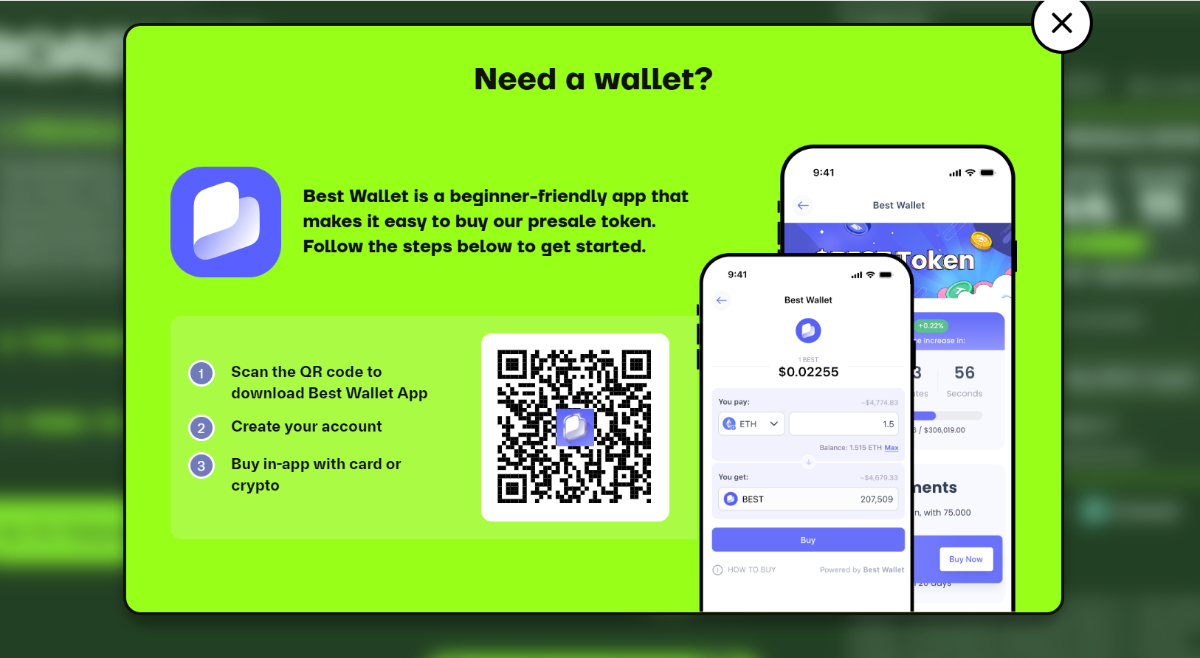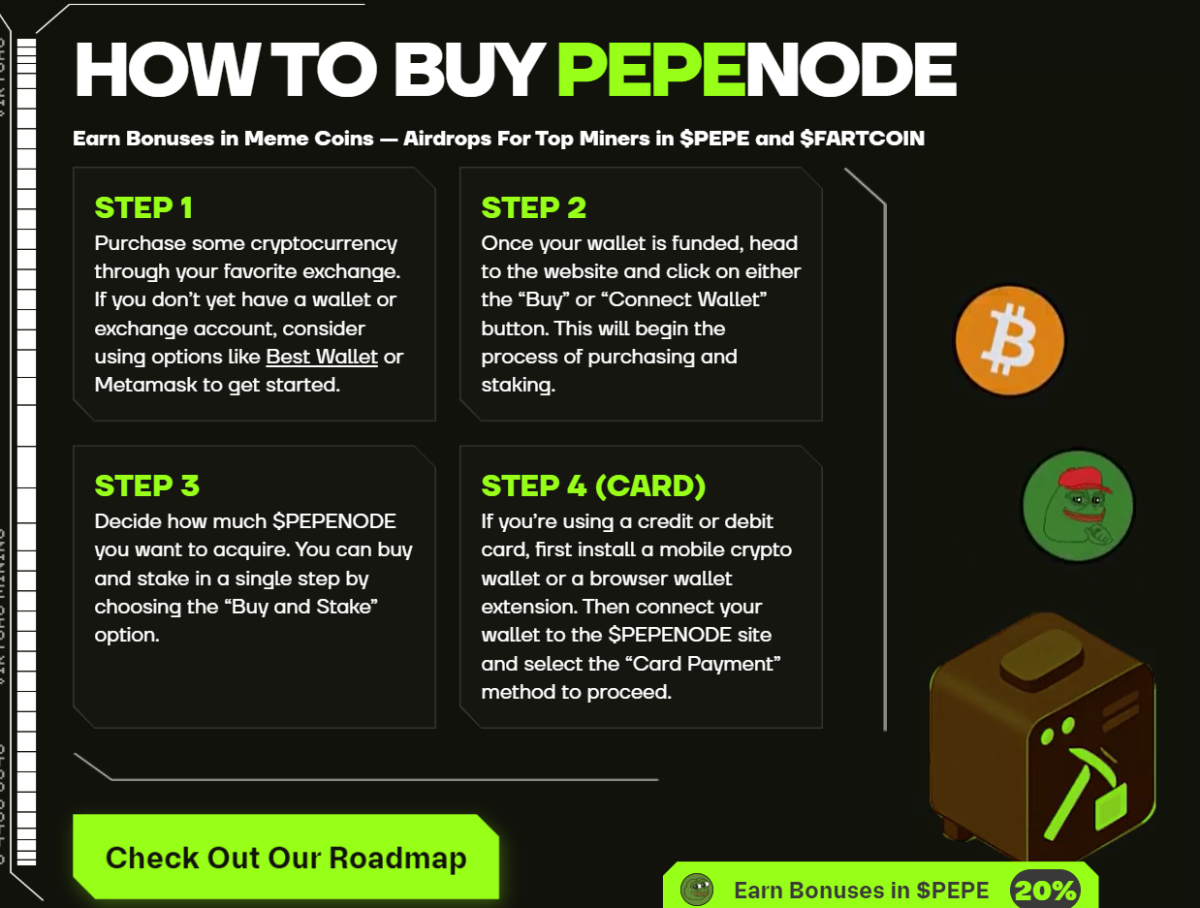This Vortex FX (VFX) price prediction guide explores prices predicted through 2026, 2030, and 2036, looking at the potential heigh...
To buy PEPENODE, you need to set up a crypto wallet and fund it with the required tokens. Here’s the full step-by-step guide to buying PEPENODE in its presale phase.
PEPENODE is a new crypto project in its presale phase that combines traditional token mechanics with a node-based earning system.
Featuring a mine-to-earn system where users purchase virtual nodes and upgrade their configurations, users can earn rewards in multiple meme coins including PEPENODE, PEPE, and FARTCOIN.
The presale uses progressive pricing, which means that each stage increases the token price. Below are the presale mechanics, timing considerations, and purchase instructions for PEPENODE.

- Build your own virtual meme coin mining rig.
- 100% virtual and requires no additional computing power.
- Top miners get additional bonuses in Pepe, Fartcoin, and other meme coins.
Quick Steps to Buy PEPENODE
- Download an Ethereum-compatible wallet. Popular picks include Best Wallet, Coinbase Wallet, and MetaMask.
- The PEPENODE presale accepts ETH, USDT, USDC, Tether, and BNB. Buy or deposit one of these into your wallet.
- Go to the PEPENODE presale site and connect your wallet.
- Pick your payment asset (matching the one in your wallet), enter the purchase amount, and confirm.
- Stake your tokens via the presale dashboard (optional).
How to Buy PEPENODE Today: Step-by-Step Guide
If you are ready to take action, here is how you can buy PEPENODE:
1. Download a Wallet
First things first – get yourself a crypto wallet that supports Ethereum or Binance Smart Chain tokens. Popular options include Best Wallet, MetaMask, or Coinbase Wallet.
If you don’t have a wallet, simply click on “I don’t have a wallet”, and PEPENODE will walk you through installing Best Wallet.

You can create a BestWallet account if you don’t have a wallet already. Source: PEPENODE
2. Fund Your Wallet
While the website has an option “buy with card,” this option is only available after you connect a wallet (so that it knows which wallet to issue the tokens to at launch).
If you choose to buy with a wallet, you’ll need to fund your wallet with one of the accepted cryptocurrencies, which include ETH, USDT, USDC, or BNB. If you don’t have crypto yet, many wallets support buying directly with a debit or credit card (including Best Wallet and MetaMask), so you can entirely skip the exchange step.
3. Visit the PEPENODE Website
If you haven’t done so already, navigate to the official presale site (pepenode.io) and connect your wallet to link it with the platform. Keep in mind that this is the official presale website, and you should make sure to check that you are on the correct URL to avoid scams.
4. Buy PEPENODE
Choose the asset you funded your wallet with and enter how many PEPENODE tokens you want to buy. The PEPENODE presale uses incremental pricing, with price increases at set intervals – daily or every few hours, depending on the stage. Each price increase means later buyers pay more per token than earlier buyers. If you’re satisfied with the number of tokens and the price you’ll pay for them, you can confirm the transaction.
5. Stake PEPENODE (Optional)
If you want to boost your rewards, you can also use the presale staking dashboard to lock your tokens and earn APY on your holdings. Staking is optional, but recommended for those who aim for bigger bonuses.
Right now, the APY for staking is 570%, but in most cases, the APYs drop post-launch.
PEPENODE Token Highlights
| Feature | Details |
| Token Symbol | PEPENODE |
| Blockchain | Ethereum / Binance Smart Chain (EVM Compatible) |
| Presale Price | $0.0012161 |
| Amount Raised | $2.61M |
| Where to buy | pepenode.io |
| Payment Options | ETH, USDT, USDC, BNB, credit and debit cards |
| Staking Options | Available directly on the presale website |
| Time Until Next Price Increase | Loading...
|
Ways to Buy PEPENODE
Right now, there are two options for buying PEPENODE tokens during the presale.
The first is with crypto by using your crypto wallet like MetaMask or BestWallet.
The other option is with a credit or debit card. Just make sure you first connect to your wallet before you select the card option during checkout.

How to buy PEPENODE- Step-by-Step. Source: PEPENODE
Tokenomics: How PEPENODE is Distributed
Let’s take a look at what the whitepaper shares about token allocation and tokenomics in general.
| Allocation | Percentage | Purpose |
| Economics & Treasury | 35% | Business growth and community activities |
| Infrastructure & Marketing | 15% | Marketing and global expansion |
| Node Rewards | 7.5% | Staking and promotional incentives |
| Growth and Listings | 7.5% | Exchange listings and liquidity |
| Protocol Development | 35% | Ongoing feature upgrades and platform improvements |
Safe Buying Tips for PEPENODE
Now let’s talk about the actual buying process. You need to make sure you are safe, which is why we recommend that you:
- Use a trusted wallet like BestWallet or MetaMask and not custodial exchange wallets.
- Double-check the URL. Check the domain to make sure you are on pepenode.io and not a fraudulent site. Don’t click on phishing emails.
- Start small first. Test the presale with a small amount to make sure everything works well.
- Save your confirmations. Keep screenshots or wallet records in case of any issues regarding your transaction.
- Stay on official channels. Use only their official channels to verify any new announcements.
Troubleshooting Tips
If you are having trouble, there are a few things you can do.
- If you’re dealing with connection issues, make sure your wallet is unlocked and the network (ETH or BSC) matches the presale’s compatible blockchain.
- If you had a failed transaction, check the gas fees. This may need adjusting during high network times. You can check Etherscan’s gas tracker to determine the current rate.
- If you are stuck on the “buy and stake” step, try switching from your browser to your mobile wallet, or just refresh the page and reconnect.
- If you can’t see the tokens after purchase, wait for the Token Generation Event (TGE) to claim them. You don’t usually receive tokens instantly during presale.
Is Now the Best Time to Buy PEPENODE?
PEPENODE combines meme culture with gamified virtual mining. Meme coins with utility features typically outperform basic tokens without use cases.
The presale offers airdrops, early-bird pricing, and staking rewards. The deflationary tokenomics reduce supply over time, which could support price if adoption grows.
PEPENODE remains a new, high-risk project. It lacks the track record and community size of established meme coins. The project’s success depends on user adoption and sustained interest in its mining mechanics.
Investors interested in gamified crypto projects may find PEPENODE worth researching. Standard investment disclaimers apply and you should conduct due diligence and invest only what you can afford to lose.
How to Buy PEPENODE FAQ
How do I buy PEPENODE tokens?
Can I stake my PEPENODE tokens?
What blockchain is PEPENODE built on?
How does the deflationary burn work?
References
- PEPENODE’s Official Whitepaper – PEPENODE
- The History of Dogecoin – Dogecoin
- What is Cryptocurrency Shiba Inu and How Does It Work – Kriptomat
- SafeMoon: From DeFi Dream to Million-Dollar Scam – Binance
- Make Your Steps Count – STEPN
- Alien Worlds Whitepaper – AlienWorlds
- What are EVM Compatible Blockchains – ThirdWeb
- What Is a Token Generation Event – Genius Academy
Coinspeaker in Numbers
Monthly Users
Articles & Guides
Research Hours
Authors
BMIC (BMIC) is a presale project that wants to create quantum-resistant security for crypto wallets and digital assets. The team s...
Wondering how to buy crypto but not sure where to start? Our beginner's guide explains how and where to invest in digital assets l...
 Fact-Checked by:
Fact-Checked by:
 7 mins
7 mins
Nadica Metuleva
, 42 postsI’m a seasoned writer with over a decade of professional experience, specializing in crypto, technology, business, and iGaming. Over the years, I’ve built a reputation as a trusted contributor to well-known outlets such as InsideBitcoins, CEOTodayMagazine, and Promo, while also collaborating with leading content and marketing agencies including Skale and Boosta. My portfolio spans a wide range of content types, exchange reviews, how-to guides, long-form comparisons, trend analyses, and thought leadership pieces, crafted to both inform and engage readers across different levels of expertise.
In the crypto space, I’ve developed a deep understanding of blockchain technology, digital assets, and the fast-moving decentralized finance (DeFi) ecosystem. I’ve written extensively on topics such as cryptocurrency exchanges, wallets, tokenomics, NFTs, and global regulatory developments. As a crypto investor myself, I bring a valuable firsthand perspective that allows me to balance technical accuracy with practical insights that resonate with traders, investors, and newcomers alike. Whether I’m breaking down blockchain mechanics or analyzing the latest market shifts, my work combines rigorous research, industry knowledge, and a keen sense of storytelling.
My educational background plays a key role in shaping my writing approach. I hold a Bachelor’s degree in Translation and a Master’s degree in English Literature and Teaching, disciplines that sharpened my ability to research complex subjects, distill technical information into accessible language, and adapt my tone to diverse audiences. This strong academic foundation underpins my clear, insightful, and authoritative style.
Passionate about making complex topics accessible, my mission is to cut through the jargon and deliver content that empowers readers to make informed decisions.
You can learn more about me and explore my portfolio on LinkedIn.